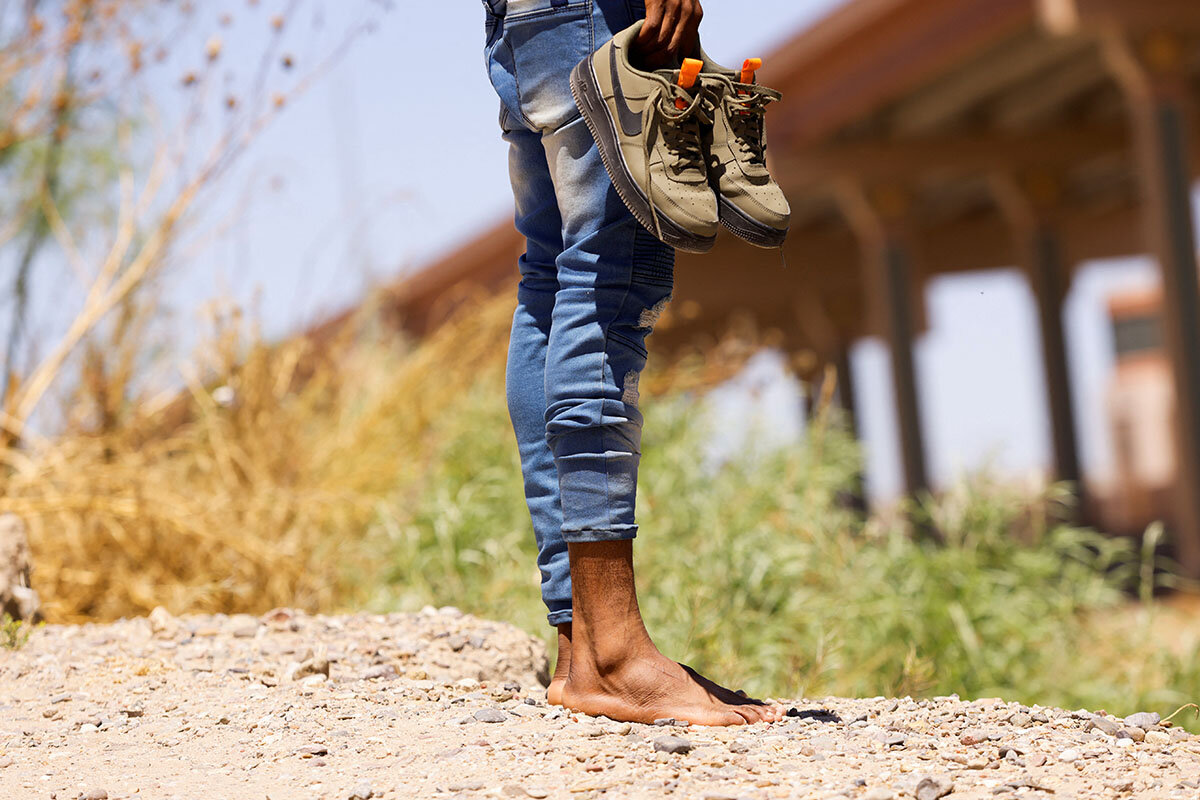Will US extend speedy Ukrainian refugee welcome to others?
Loading...
| Tijuana, Mexico
On a recent sunny afternoon, two refugees sat in shelters a few blocks apart, not far from the U.S. border. Both women had fled a sudden onslaught of violence that upended their lives. Both had flown to Tijuana hoping to enter the United States. Neither knew what to expect.
Only one of them – Kristina from Ukraine – would be given refuge in the U.S.
Graciela, from Mexico, has spent the past three months sleeping in a crowded tent in a migrant shelter, waiting for a chance to present her asylum claim to U.S. officials. She’s still there.
Why We Wrote This
While Central American asylum-seekers are blocked at the U.S. border, Ukrainian refugees have been whisked through. Could that discrimination have a silver lining?
She says it’s hard to beat back feelings of jealousy. “I hope they make it to their destination,” she says of the vanloads of Ukrainian refugees she’s seen ferried past her shelter by volunteers. “But it’s hard not to wonder: Why them and not us?”
Kristina, an aspiring athletic-wear designer, knows nothing of Graciela’s fate. She has not stepped foot outside her shelter since she arrived. But she knows she’s fortunate to have escaped Odesa, where a family of acquaintances was killed in a Russian missile attack last month.
“I hope in the U.S. I finally feel safe,” she says. As a Ukrainian, she was exempted from the COVID-19 rule holding Graciela back.��
The two women’s stories illustrate a glaring disparity in the ways U.S. border authorities treat different refugees. But, some see a silver lining in Kristina’s experience, and that of thousands of her compatriots.
U.S. border officials have for years explained the long delays facing Graciela and people like her from Central America, Haiti, and elsewhere in Latin America, by a lack of staff. Now, “there is no justification for … saying the resources don’t exist. It’s only about where resources are directed,” says Soraya Vázquez, deputy director of the Tijuana branch of Al Otro Lado, a legal aid organization.
“With the arrival of the Ukrainians we saw they only have to choose to put those resources toward the situation at the border.”
��
“Completely stressed”
Graciela woke up earlier this year to the shouted orders of armed men. Her family was forced out of their home by strangers dressed in what looked like police uniforms, but without any official insignias. The men burned down her home, and the houses on either side of it, kidnapped her husband and two neighbors, and left.��
“Who were they? What did they want?” she asks, squeezing the hand of her granddaughter who sits beside her on a folding chair at the back of a Tijuana shelter. The family got away as fast as they could, unsure if the attackers would come back. They took shelter in a church, which provided them with clothes, food, and help buying plane tickets to the border.
“My only thought was we needed to get as far away as possible,” Graciela says, tears rolling down under her mask. “We had no idea the border was closed.”
It remains closed by Title 42, a Trump-era public health order implemented to slow the arrival of COVID-19 across U.S. borders. It soon transformed into an immigration-enforcement tool, keeping migrants and refugees out, even as mask bans and other pandemic restrictions are lifted.
U.S. migration policy has been “extremely restrictive” on its southern border for decades, says Juan Antonio Del Monte, a researcher at the College of the Northern Border outside Tijuana. Now, he says, “the system is completely stressed.”
Thousands of migrants and refugees, mostly from Mexico and Central America, have crowded into temporary shelters dotted around Tijuana. Children kick deflated soccer balls and clamber on chain-link fences while parents cook on open stoves or scroll through their mobile phones, looking for promising news. Come nightfall, bunk beds, tents, and flimsy mattresses cover every inch of floor space.
Some shelters are building extensions, their concrete foundations and steel frames symbolizing the increasing permanence of what refugees had hoped would be a temporary wait.
Even if Title 42 is revoked, it is unclear how easily Latin American refugees would secure asylum interviews with Border Patrol officials.�� Before the COVID-19 restriction, U.S. officials operated a metered system that allowed 10 to 15 refugees each day the chance to approach the port of entry in Tijuana.��
Ukrainian refugees, on the other hand, were processed by the hundreds every day after they began arriving here in early March. An estimated 14,000 were granted one-year humanitarian permits to enter the United States through late April.
“This shows that with political will, you can get things done,” says Dr. Del Monte. “Ukrainians were processed quickly and efficiently.” The U.S. authorities “have demonstrated they can handle this.”
An outpouring of support
Also working in the Ukrainian refugees’ favor are compatriots who rallied to help them, setting an example of solidarity that local advocates would like to see replicated among other immigrant communities.
“They arrived from the other side of the world and were met by a community of Ukrainians from the U.S. who supported them and managed everything in an orderly way,” says José Maria Garcia Lara, director of the Movimiento Juventud 2000 shelter.
Inna Levien, a volunteer coordinator from Orange County, is proud of the work she and an estimated 4,000 others pulled off in Tijuana.
“There’s just been an outpouring of support: churches with supplies, help from the local government. All needs have been met,” she says.
That means that money was instantly forthcoming to pay for plane tickets to Mexico City, where Ukrainians in Mexico are now waiting for entry to the U.S. through the newly launched Uniting for Ukraine program. It means that the Unidad Deportivo de Benito Juarez refugee shelter, which three years ago was a densely packed, muddy crush of Central American families, has been transformed into a comfortable haven, serving Ukrainians ham, cheese, and lettuce sandwiches. And, it means that somebody was there to help Kristina Koleganova, the young woman from Odesa, quickly fill out the paperwork that will get her into the U.S.
The volunteers “didn’t just arrive with materials, like beds and food, but with legal support and guidance. That’s something we need to replicate among other groups,” says Dr. Del Monte.
“It will require political will. But we can’t do that if there isn’t money,” he says.
Racism is also at play, migration experts say. There’s broad agreement that it was a good thing that U.S. officials helped Ukrainian refugees into the U.S. so speedily. But, it’s hard not to notice the physical and economic differences between those ushered through – and those who have been stuck waiting at the border for months, if not years.
“Even if you don’t want to believe it, it’s real,” Ms. Vázquez says. “Poor people with dark skin are not treated the same way” at U.S. ports of entry.
On the outskirts of Tijuana, nearly 1,000 migrants and refugees have hunkered down at the Embajada de Jesus shelter. Ruby, who fled an abusive partner in a violent corner of Mexico eight months ago, watches as her 11-year-old son practices the song “Despacito” on a donated guitar.��
“Watching the Ukrainians cross the border, it felt like someone was clipping my wings,” she says. “If my eyes were blue, or my hair was yellow, would my family’s story be different?” she asks. “Even if we are all fleeing different situations, at the end of the day, it’s all the same.
“We’re all running for our lives.”








